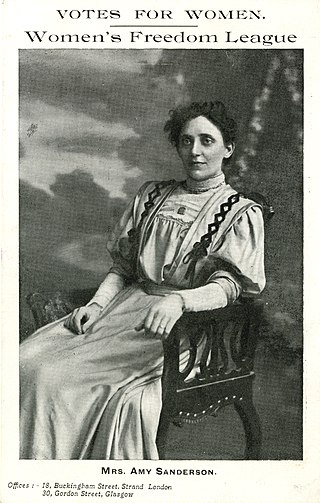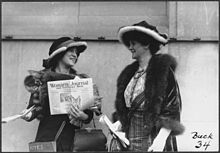
Lucy Burns was an American suffragist and women's rights advocate. She was a passionate activist in the United States and the United Kingdom, who joined the militant suffragettes. Burns was a close friend of Alice Paul, and together they ultimately formed the National Woman's Party.

Charlotte Despard was an Anglo-Irish suffragist, socialist, pacifist, Sinn Féin activist, and novelist. She was a founding member of the Women's Freedom League, the Women's Peace Crusade, and the Irish Women's Franchise League, and an activist in a wide range of political organizations over the course of her life, including among others the Women's Social and Political Union, Humanitarian League, Labour Party, Cumann na mBan, and the Communist Party of Great Britain.

A suffragette was a member of an activist women's organisation in the early 20th century who, under the banner "Votes for Women", fought for the right to vote in public elections in the United Kingdom. The term refers in particular to members of the British Women's Social and Political Union (WSPU), a women-only movement founded in 1903 by Emmeline Pankhurst, which engaged in direct action and civil disobedience. In 1906, a reporter writing in the Daily Mail coined the term suffragette for the WSPU, derived from suffragistα, in order to belittle the women advocating women's suffrage. The militants embraced the new name, even adopting it for use as the title of the newspaper published by the WSPU.

Margaret Mary Heckler was an American politician and diplomat who represented Massachusetts's 10th congressional district in the United States House of Representatives from 1967 until 1983. A member of the Republican Party, she also served as the 15th United States Secretary of Health and Human Services from 1983 to 1985, as well as United States ambassador to Ireland from 1986 to 1989.

Maud Wood Park was an American suffragist and women's rights activist.

Helen Miller Fraser, later Moyes, was a Scottish suffragist, feminist, educationalist and Liberal Party politician who later emigrated to Australia.
The Massachusetts Woman Suffrage Association (MWSA) was an American organization devoted to women's suffrage in Massachusetts. It was active from 1870 to 1919.

The Boston Equal Suffrage Association for Good Government (BESAGG) was an American organization devoted to women's suffrage in Massachusetts. It was active from 1901 to 1920. Like the College Equal Suffrage League, it attracted younger, less risk-averse members than some of the more established organizations. BESAGG played an important role in the ratification of the 19th amendment in Massachusetts. After 1920, it became the Boston League of Women Voters.

Women's suffrage in Wales has historically been marginalised due to the prominence of societies and political groups in England which led the reform for women throughout the United Kingdom. Due to differing social structures and a heavily industrialised working-class society, the growth of a national movement in Wales grew but then stuttered in the late nineteenth century in comparison with that of England. Nevertheless, distinct Welsh groups and individuals rose to prominence and were vocal in the rise of suffrage in Wales and the rest of Great Britain.

Josephine Collins was a suffragist fighting for a woman's right to vote. She was the first born daughter of Irish immigrants Cornelius and Catherine (Horrigan) Collins. She had one sister and five brothers. The family lived in Framingham, Massachusetts.

Minnie Bronson was an American anti-suffragist activist who was general secretary of the National Association Opposed to Woman Suffrage.
Patricia Woodlock was a British artist and suffragette who was imprisoned seven times, including serving the longest suffragette prison sentence in 1908 ; she was awarded a Women's Social and Political Union (WSPU) Hunger Strike Medal for Valour. Her harsh sentence caused outrage among supporters and inspired others to join the protests. Her release was celebrated in Liverpool and London and drawn as a dreadnought warship, on the cover of the WSPU Votes for Women newsletter.

Amy Sanderson née Reid (1876–1931), was a Scottish suffragette, national executive committee member of the Women's Freedom League, who was imprisoned twice. She was key speaker at the 1912 Hyde Park women's rally, after marching from Edinburgh to London, and, with Charlotte Despard and Teresa Billington-Greig, was a British delegate to the 1908 and 1923 international women's congresses.

Mary Hutcheson Page was an American Suffragist from Brookline, Massachusetts. She was a member and leader of suffrage organizations at both the state and national levels, wrote on the subject of suffrage for a variety of publications. She worked with other American suffragists Carrie Chapman Catt and Susan B. Anthony.

Horatia Dorothy MoloneyLancaster (variously known as Dorothy,Mary, Dolly,Miss Maloney and Miss Molony, Moloney and O'Connor) was an Irish suffragette campaigner and member of the Women's Social and Political Union (WSPU). She became Organiser to the London Council of the Women's Freedom League in 1908, following its split from the WSPU. She famously disrupted the 1908 Dundee by-election by ringing a bell every time Winston Churchill attempted to address a crowd demanding that he apologize for insulting remarks he had made about the women's suffrage movement.

This is a timeline of women's suffrage in Montana. The fight for women's suffrage in Montana started earlier, before even Montana became a state. In 1887, women gained the right to vote in school board elections and on tax issues. In the years that followed, women battled for full, equal suffrage, which culminated in a year-long campaign in 1914 when they became one of eleven states with equal voting rights for most women. Montana ratified the Nineteenth Amendment on August 2, 1919 and was the thirteenth state to ratify. Native American women voters did not have equal rights to vote until 1924.

The women's suffrage movement in Montana started while it was still a territory. The Women's Christian Temperance Union (WCTU) was an early organizer that supported suffrage in the state, arriving in 1883. Women were given the right to vote in school board elections and on tax issues in 1887. When the state constitutional convention was held in 1889, Clara McAdow and Perry McAdow invited suffragist Henry Blackwell to speak to the delegates about equal women's suffrage. While that proposition did not pass, women retained their right to vote in school and tax elections as Montana became a state. In 1895, National American Woman Suffrage Association (NAWSA) came to Montana to organize local groups. Montana suffragists held a convention and created the Montana Woman's Suffrage Association (MWSA). Suffragists continued to organize, hold conventions and lobby the Montana Legislature for women's suffrage through the end of the nineteenth century. In the early twentieth century, Jeannette Rankin became a driving force around the women's suffrage movement in Montana. By January 1913, a women's suffrage bill had passed the Montana Legislature and went out as a referendum. Suffragists launched an all-out campaign leading up to the vote. They traveled throughout Montana giving speeches and holding rallies. They sent out thousands of letters and printed thousands of pamphlets and journals to hand out. Suffragists set up booths at the Montana State Fair and they held parades. Finally, after a somewhat contested election on November 3, 1914, the suffragists won the vote. Montana became one of eleven states with equal suffrage for most women. When the Nineteenth Amendment was passed, Montana ratified it on August 2, 1919. It wasn't until 1924 with the passage of the Indian Citizenship Act that Native American women gained the right to vote.

Edith Mary Sutton (1862–1957) was the first woman to become a councillor in England, the first female mayor in Reading, and a suffragist.
Mae Caine was a 20th-century American suffragist and women's rights activist, civic leader, and government official in Nevada. President of the Suffrage Society in Elko County, she was also a vice president of the Nevada Equal Franchise Society, and a delegate from Nevada to the 45th convention of the National American Woman Suffrage Association in Washington, D.C.
















